Around the Oval
Foreign Assignment
UM Journalism Students Conduct Exchange With Czech Peers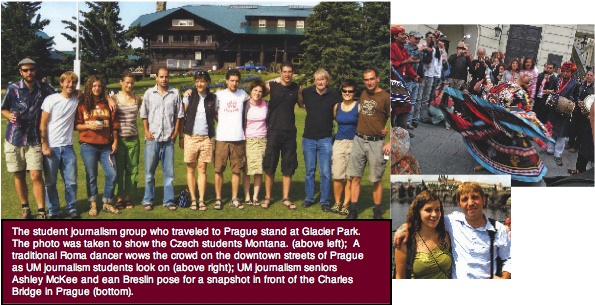
For five University of Montana journalism students, the city of Prague felt nothing short of a colossal theme park. Former J-School Dean Charlie Hood, our chaperone/tour guide/editor extraordinaire, led us through a sea of rainbow-colored, centuries-old elaborate buildings and statues on cobblestone-paved sidewalks. We couldn’t read anything. We couldn’t understand anyone.
We spent our days trekking through Prague on foot, using our Missoula-sized sense of direction to navigate a city of about 1.2 million people. Between the unfamiliar streets and the language barrier, everyday tasks like buying food and finding a bathroom became complicated treasure hunts.
Thankfully, our Czech counterparts (we still haven’t tired of calling them our “Czechmates”) spoke English beautifully and were happy to guide us through their country. They showed us the best Chinese food in town, took us to a professional football (soccer) game and taught us that shots of espresso were to be sucked down, not sipped.
But most of all, the Czechs helped us track down stories for our project, Common Ground. To us, the Roma people of Europe were a total mystery. The Czech students guided us through a foreign society that we knew little about. As we learned more, it was clear that minorities in Europe face many of the same issues as minorities in the United States.
While doing research within the Roma community, we soon learned that the Roma struggle with forced assimilation and discriminatory laws. We thought we were going to another country to learn more about a minority group, but we came out of it with not only more insight into the Roma society, but also more knowledge of our own moral standards. With the help of our partners, we were able to communicate with the Roma people and develop stories about issues they felt were important to address.
Our roles were reversed when we returned to Montana and our Czech peers arrived. Whether it was sitting in on a tribal council meeting on the Flathead Reservation or learning about the Blackfeet language, the Czechs relied on us to introduce them to American Indian issues.
But we also introduced them to Missoula, and we quickly learned our foreign friends were up for anything. We danced to bluegrass music at the Top Hat and visited Glacier National Park, where we saw a moose and two bears.
The exchange lasted a total of two months—time that went by too quickly for all of us. Of all the classes we’ve taken and all the people we’ve met through our college careers, we’re sure to remember this assignment vividly.
– Sean Breslin and Ashley McKee
Research Reveals Bird Flight Secret
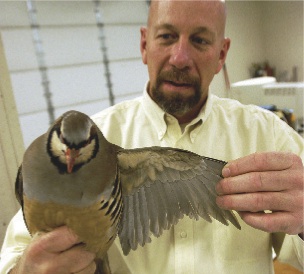 Often mysteries are hidden right in front of us, but human eyes aren’t quick enough to detect them. That’s where UM biology Professor Ken Dial and his high-speed cameras come in.
Often mysteries are hidden right in front of us, but human eyes aren’t quick enough to detect them. That’s where UM biology Professor Ken Dial and his high-speed cameras come in.
Dial, director of the University’s Flight Laboratory, has used high-speed imagery to slow down blurring wings enough to show that all birds use the same basic wing angle relative to the ground to gain altitude, glide, descend, or run up steep surfaces.
He says this fundamental wing stroke may help explain how birds evolved to take to the skies.
“I think many big findings in biology are fairly straightforward common sense,” he says. “That’s where the beauty of this resides—its simplicity and utility are quite striking.”
Dial used chukars, a type of partridge, in the initial research and later confirmed the fundamental wing stroke among twenty other bird species.
During his twenty-five years studying flight, the researcher often photographed birds in wind tunnels to learn how they use their wings. His recent research also studied adolescent birds as they learned to fly.
“We figured the stroke angles were going to be all over the place, but it turned out to be just a single stroke,” he says.
The fundamental stroke is confined to a narrow range of less than 20 degrees, which directs aerodynamic forces above the horizontal, permitting a 180-degree range in the direction of travel.
Did avian ancestors first take wing by climbing and then gliding from trees? By running along the ground, beating their feathered forelimbs, and taking off? Dial now offers a third theory—the ontogenetic-transitional wing hypothesis—which suggests birds evolved incrementally by learning to use their wings to run up steep surfaces. His previous work already has shown that birds use their wings like the spoiler on a race car to run up steep inclines.
Dial’s new findings recently were published in the international science journal Nature.
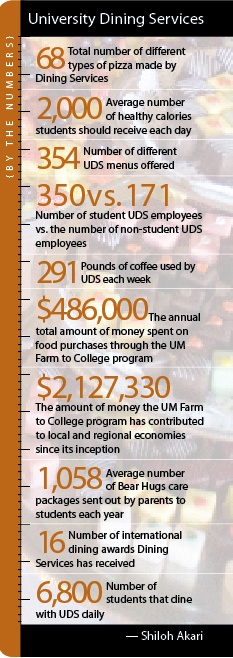
A Legacy of Permanence and Quality
Mike Mansfield entrusted UM to carry on his legacy and his wife Maureen’s, through an academic center for students.
This year, the Maureen and Mike Mansfield Center celebrates twenty-five years of furthering its mission to promote the central themes of Mansfield’s unique career—ethics and public affairs, and modern Asian studies.
Mansfield, who credits his wife, Maureen, with his success, was the longest-serving Senate Majority Leader in U.S. history and later ambassador to Japan. Mansfield continues to be recognized for his dignity, morality, and bipartisanship.
This year the center created a critical language program in Chinese with a $1.8 million grant from the Department of Defense, and its new Juries and Democracy Program will train leaders to promote democracy through jury development in Japan, Korea, and China.
Terry Weidner, director of the Mansfield Center, attributes the international access of the Montana center to its accomplishments, the “enormous respect” that the Japanese had for Mansfield, and The Maureen and Mike Mansfield Foundation—with offices in Washington, D.C., Tokyo, Japan, and Missoula.
Following six years of discussion between the Mansfields, UM administration, and faculty, the center was founded with a congressional endowment that continues to provide funding.
In 1983 Regents Professor Paul Lauren became the center’s first director and was instrumental in establishing the Mansfield Conference, the center’s premier annual event that promotes open discussion on the two pillars of Mansfield’s career.
At the 1986 Mansfield Conference, more than 5,000 people filled UM’s Dahlberg Arena to hear former President Jimmy Carter, the keynote speaker. Five years later, at the Japan’s Emerging Role in the World conference, Mansfield himself addressed an even larger audience.
Mansfield’s life is a testament to the American dream. Before his fifty years of public service began, Mansfield lied about his age and enlisted in the Navy as a fourteen-year-old in World War I. Then he served as a Marine and worked for eight years in the coal mines of Butte. There, Mansfield met his future wife, Maureen, who encouraged him to seek a college degree. He earned a master’s degree in history and political science in 1934 and taught at UM until he entered politics in 1942.
Despite living in Washington, D.C., for most of Mike’s political career, the Mansfields never lost touch with Montana, sending Christmas cards to their constituents each year.
Weidner says the center remains true to the Mansfield spirit.
“In everything we try to do, we try to look at overarching issues that really concern not just Asia, but all the folks in Montana.”
– Ashley Zuelke
UM Commercials Net Awards
Two years ago, UM embarked on a marketing campaign meant to highlight the University’s strong sense of community, unique campus setting, and world-class faculty.
Now UM is being rewarded for its efforts. In February the University’s television campaign received six awards, including one Best of Show for a commercial featuring UM assistant professor of anthropology Kelly Dixon, at the 2007 ADDY Awards Competition in Great Falls. In March UM also received a national award for the commercial featuring Dixon—a silver distinction—this time from the annual Admissions Advertising Awards competition hosted by the Admissions Marketing Report.
Dixon is known for her archaeological work on the Donner Party campsite in California and at the Coloma ghost town east of Missoula. The Coloma dig site, overlooking a scenic mountain valley, provided a striking backdrop for the commercial, which shows Dixon and her students examining remnants from a dilapidated log cabin on the outskirts of the abandoned mining town.
The University’s comprehensive marketing campaign is spearheaded by UM Executive Vice President Jim Foley. All commercials are filmed by Chisel Industries, a Montana company, using 35-millimeter film and specialized lighting and camera techniques to produce polished, vivid work.
In 2006 UM’s “Griz Country” commercial took home Best of Show at the ADDY awards, and won a silver in the regional ADDY competition.
Graduate Student Snares $80,000 Scholarship
Bighorn sheep have a big friend in UM doctoral student Heather Johnson.
A wildlife biology major from Bellevue, Washington, Johnson works to save endangered bighorns as an employee of the Sierra Nevada Bighorn Sheep Recovery Program of the California Department of Game and Fish.
Now her efforts have been rewarded with a three-year $80,000 scholarship from the 2007 Canon National Parks Sciences Scholars program. She was one of only four in the nation to earn the award.
“I’m ecstatic about it,” she says. “It’s a big one to get. It was great to see the review of my proposal. I’m encouraged to see how excited they were about what we are doing.”
Johnson strives to preserve a California bighorn sheep subspecies that is distinct from the Rocky Mountain bighorns found in Montana. She works in the field with the animals during the winter and summer months.
The Canon program supports the development of the next generation of students in the fields of conservation, environmental science, and park management. It’s sponsored by Canon U.S.A., the American Association for the Advancement of Science, and the U.S. National Park Service.
Johnson’s adviser, Professor Scott Mills, notes his student was selected from a pool of 150 applicants. “The competition was incredible,” he says.
The President's Corner

What do Susan Gibson, Bo Brown, and Dan Pletscher have in common? They share a creative relationship with The University of Montana, each in a distinctive way. Susan Gibson won acclaim as a songwriter and singer who wrote her most famous song while a student at the University. Bo Brown has enjoyed a distinguished career as an academic and a promoter of professional theatre, starting with the establishment of the Montana Rep at the University in the 1960s and then moving to other and larger venues. Dan Pletscher has provided leadership to the Wildlife Biology Program at the University, taking it from a good program to world-class during his tenure. These three individuals—through their very different but equally impressive creative accomplishments —have contributed to the mystique and image of The University of Montana. It seems manifestly clear that the University benefits immensely from these relationships, gaining stature and status through the accomplishments and fame of its students and faculty. But why expect otherwise? Most people identify a university by its students, alumni, faculty, and staff, not by its buildings or corporate structure. The University of Montana has prospered because of the quality and achievements of its people.
In recognition of the special value of these relationships, we of the University seek to nurture and tout them. Every issue of the Montanan features students, alumni, faculty, or staff members and their accomplishments. The recent and award-winning television pieces to inform people about the University provide the means to showcase outstanding individuals. The gatherings sponsored by the UM Foundation and Alumni Association have the explicit purpose of cementing and stewarding such relationships. The recently completed and hugely successful campaign, Invest in Discovery, relied fully on these relationships for its success. Of perhaps even greater importance, that campaign re-established some relationships that had declined over the years—some 8,000—and we will work hard to nourish and revitalize them because of all that they mean to the University. For universities, as for individuals, relationships matter because of the meaning they provide and their capacity to enhance the quality of community life.
With these ideas and associations in mind, I often paraphrase the eloquent but brief words used by founding President Oscar John Craig as a tribute to the emerging university he guided to development: “The University—It Shall Prosper!” My paraphrase gets it right, in my view: “The University—Because of You, It Shall Prosper!” And so it has, over the years, because of the commitment to allow its students, alumni, faculty, and staff to realize their full potential.
George M. Dennison, ’62, ’63
President and Professor of History
Taking It To The Streets
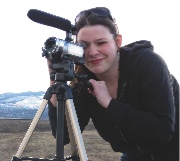
K’Lynn Sloan was inspired to apply for
MTV’s Choose or Lose Street Team ’08 election coverage because of a simple caption.
“It had a picture of the White House Press Corps with a caption that read ‘Why let these guys have all the fun?’” says Sloan, a 2007 graduate of the UM radio-television department.
And now Sloan is the one having all the fun. In January she was selected as one of fifty-one citizen journalists around the country whose job it is to report political and social issues affecting youth. Sloan submits weekly multimedia reports on MTV’s social activism Web site, www.think.mtv.com and also updates a blog discussing the issues she reports.
“I just feel really honored to be a part of this project and to have an opportunity to cover the 2008 election in an exciting and fun way,” Sloan says. “I knew I didn’t want to just be a spectator during this election, and now I’m covering it for young people and for Montanans.”
Sloan also hopes to inspire more young people to join MTV’s Think Web site, which also serves as a social networking platform for youth to join and discuss issues and causes that are important to them.
“Three months ago when I started, people in Montana were still in the mind-set that we can talk about the election, but our voice doesn’t really matter,” Sloan says. “In a few short months, that’s changed entirely. Now I speak to young people who are amazed that we may see candidates in this state and feel like our June primary may actually be important. It’s an election unlike any other.”
Sloan’s work can be viewed at www.streetteam08.com.
PHYSICS STUDENT SHOOTS FOR THE STARS, LANDS IN ENGLAND
UM senior Hilary Martens keeps racking up the honors.
She’s already a Presidential Leadership Scholar at UM. In 2007, she was named one of Glamour magazine's Top Ten College Women. She’s been awarded the Goldwater Scholarship for excellence in and commitment to science and the UM Watkins Scholarship for research. She was inducted into the Honor Society of Phi Kappa Phi in 2005.
And Martens recently added to her extensive list of accomplishments when she became just the second Grizzly ever to receive the prestigious Marshall Scholarship, good for two years of graduate school at British universities.
Martens will graduate from UM in May with degrees in physics and music and a minor in mathematics. This fall, she’ll continue her science studies, first at University College London, then at University of Aberystwyth, Wales, or perhaps the University of Edinburgh. The British government covers all expenses for Marshall Scholarship recipients.

Meet Grizwald, The University of Montana’s cartoon bear. In the last issue of the Montanan, we asked readers to submit captions explaining Grizwald’s actions in a funny way. This issue’s winning caption was sent in by Phil Doty ’64, M.ED.’74. Congratulations, Phil, you’ve won a Griz stadium blanket!
Stay tuned. In the fall issue of the Montanan a new cartoon featuring Grizwald will need a caption. You could be the next winner!
Notable and Quotable
James McKusick, dean of the Davidson Honors College, (who appeared in the fall 2007 Montanan) recently has received a wave of publicity for the Oxford University Press edition of Goethe’s Faust, Translated by Samuel Taylor Coleridge, which he co-edited with Frederick Burwick. The London Times Literary Supplement has published a favorable review of their findings; The Chronicle of Higher Education recently profiled his work; a group of three U.K. scholars have published a thirty-six page criticism of the volume; and Christoph Bode—a distinguished German professor of English Romanticism at the University of Munich—has published a review essay supporting McKusick’s and Burwick’s attribution of the translation to Coleridge. All of these articles can be read on the “Friends of Coleridge” Web site at www.friendsofcoleridge.com/Faustus.htm.
Preservation Excellence Awards were presented at a ceremony on February 24 to members of the University Area Homeowners Association. The awards, given by the Montana Preservation Alliance, credited the members of the homeowners association with working for more than thirty years to prevent the construction of inappropriate structures in the historic University District and playing an integral role in encouraging home owners to restore and maintain homes to ensure continuation of the unique residential character of the neighborhood. The efforts by neighborhood volunteers to preserve and protect the University area were highlighted in the fall 2007 edition of the Montanan in an article by Don Oliver.
Writer Ginny Merriam received a gold award in feature writing from the Council for Advancement and Support of Education District VIII for the story about Dr. Carlos Duran and the International Heart Institute she wrote for the Montanan (The Cutting Edge, spring 2007). The Montanan also received a merit in the external publications category of the national Admissions Advertising Awards Competition, sponsored by the Admissions Marketing Report.
All Roads Lead To Montana
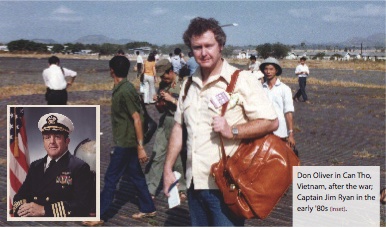
[Editor’s Note: Tell us your best Montana connection, because as you surely know by now, everywhere you go, you can make one. Send submissions, along with your date of graduation, or class years where appropriate, to: themontanan@umontana.edu. Winning stories will be compiled into an upcoming Montanan feature. All entries become property of University Relations, and we retain the right to edit and publish the material.]
It was August 1979. The Vietnam War had been over for more than four years, but there was still a steady stream of Vietnamese trying to escape the Communists who ruled their country. Most of them slipped away in leaky old boats and tried to sail the South China Sea to any safe harbor. The boats often didn’t make it, and the Vietnamese were easy prey for pirates.
I was a member of a small pool of journalists on board the aircraft carrier USS Kitty Hawk on maneuvers in the South China Sea. One of the missions of the six-ship task group was to look for and rescue any Vietnamese boat people in distress.
The third morning out we were told the USS Wabash, the ship carrying fuel for aircraft and other vessels, had rescued fifteen to twenty Vietnamese refugees during the night. We journalists were transferred to the Wabash, where we interviewed and photographed the Vietnamese. The skipper of the Wabash, Jim Ryan, invited us to his quarters for refreshments. Settling in with soft drinks, we asked Captain Jim Ryan questions about the rescue. Then one of the reporters asked Ryan where he was from.
“Montana,” he replied. I chimed in and said, “I’m from Montana too—from Billings.” Then to my amazement, he said he also was from Billings and that he had lived on Avenue E. So had I.
Others in the room began listening to see how this was going to play out. “What block did you live on?” he asked. “The 200,” I replied. With a big grin he said that’s where he had lived.
It turned out our families lived across the street and down one house from each other from the late ’40s into the mid-’50s, but our paths had never crossed. In 1950 when I started high school, Jim had gone off to Missoula to attend The University of Montana (then called Montana State University). By the time I got to Missoula four years later, Jim already had departed the University to become a Navy pilot and, later in his career, the captain of the aircraft carrier Lexington.
A week or so after our first meeting, we met for lunch in Hong Kong. By then he had been joined by his wife, Margie, a Billings girl who had flown in from the United States to help Jim enjoy his liberty. We all marveled that it took the efforts of the Navy and a group of Vietnamese boat people on the South China Sea to bring together two Griz from the same block in Billings, Montana.
– Don Oliver ’58
Lady Griz Conquer Big Sky Conference

Let’s say at the beginning of the college basketball season you make the prediction that the Lady Griz, under the guidance of Head Coach Robin Selvig, will make it into the NCAA basketball tournament. Statistically speaking, without even looking at the roster of talent on the season’s lineup, you’d have about a 57 percent chance of being correct.
This year Robin Selvig’s Lady Grizzlies qualified for their seventeenth appearance in the NCAA tournament in his thirty years as coach. That is a stat that most basketball programs in the country—men or women—would envy. Of course, real UM fans believe Montana will make it every year, but most schools dream of the day their team might qualify for the big dance.
But even though the Lady Griz made it to the dance, when the team played No. 4-ranked Vanderbilt University, they lost 75-47 against the Commodores in the opening round of the 2008 NCAA Division I Women’s Basketball Championship on Saturday, March 22, in Albuquerque, New Mexico.
The Commodores forced twenty-two turnovers, and Montana only shot at 29.4 percent. The Lady Griz were within four points with less than eight minutes to play in the first half, but a scoring run by Vanderbilt left Montana down by twenty-three at the half. The Lady Griz could not catch up and trailed by twenty points, or more, the rest of the game.
“I thought we could play them tough, but everything had to go right for us,” Selvig says. “They (Vanderbilt) played great defense and we shot poorly, but I give them all the credit in the world. They are an awfully good basketball team.”
The Lady Griz have more to celebrate when it comes to their Big Sky Conference Championship victory over rival MSU. Having won the regular season conference championship, UM hosted the conference tournament and had an offensive explosion, beating Portland State 94-80 in the semifinal game and Montana State 101-65 in the championship. Junior guard Mandy Morales scored fifty-five points, had fourteen assists and eleven rebounds in the two games to earn tournament MVP honors to go along with her third first team All-Big Sky Conference selection.
There are too many talented players and far too many great moments from the Lady Griz season to cover it all here, but there are some highlights. Heading into the NCAA tourney, junior Sonya Rogers was the nation’s most accurate three-point shooter. Rogers’ season percentage of 48.6 put her on top of NCAA statistics for three-point field goal percentage. The Lady Griz also ranked in the top ten in the nation in free throw percentage, sitting at eighth at 77.8 percent. Montana also ranked just outside of the top ten in scoring offense, coming in eleventh at 75.6 points per game.
With players like Morales and Rogers returning next year, the odds will likely improve for Selvig and his team to make it back to the NCAA tournament in 2009.
Where's Your GRIZ Been?

Shannon Noble ’97 (left), friend Jenn Standley (middle), and Standley’s daughter, Lexi (right), share their Griz pride at the seventy-fifth commemorative football game between the Baltimore Ravens and the Pittsburgh Steelers on November 5. “I also got a picture of past Griz player Justin Green, who made a nice play for the Ravens that night,” Noble writes.
Congratulations, Shannon. You’ve won a $50 gift card to The Bookstore at UM.
Do you have a photo sporting your Griz gear in an amazing place? If so, send it, along with a brief description to: themontanan@umontana.edu. Winners will receive a $50 gift certificate to The Bookstore at UM and see their winning photo published in the Montanan. To be considered, photos must be in focus with the UM or Griz logo clearly visible.